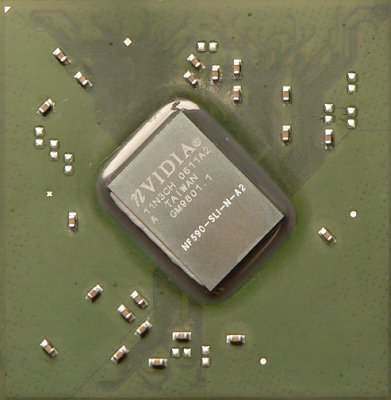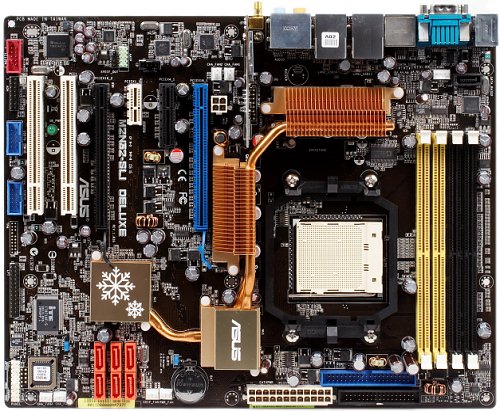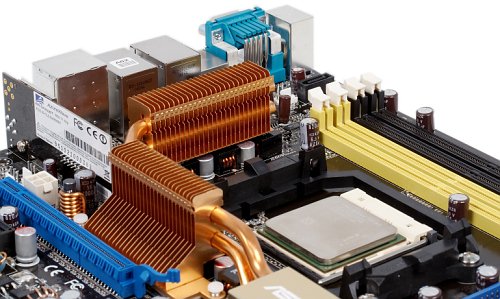 |
||
|
||
| ||
Our tests demonstrated that performance differences in synthetic tests (low resolutions and low graphic settings) even between quite different processors (a dual core processor of the new architecture and a formally discontinued single core processor) disappear in heavier modes, which make more practical sense. It does not at all mean that CPU manufacturers will not attempt to attract gamers. We already know what "carrot" manufacturers will offer us for the nearest several years — realistic physics. As is well known, it requires multithreaded computations, which unexpectedly (?) matches with the prospects of multicore future of CPUs. But the fact remains, it's all up to a video system in games now. Thus, it's not surprising that chipset manufacturers spend much marketing trouble over explaining consumers that only their top chipset works with a video tandem in an optimal way. For example, ATI claims that its CrossFire implementation in Xpress 3200 is good because a single chip is responsible for supporting PCI Express lanes, required for graphics ports (so it allows efficient cooperation between the cards). NVIDIA parries that nForce 590 SLI supports LinkBoost — automatic 25% increase in frequency of graphics ports and the bus between chipset bridges. It's irrelevant that even when the x8+x8 graphics ports are upgraded to x16+x16, the gain is not that significant (if we take into account only high resolutions and heavy graphics settings used for high-end components) and the effect of additional overclocking of buses (which are not very loaded even without it) is hard to detect even in synthetic tests. There will always be people ready to spend money for the lack of even theoretical bottlenecks in their computers. Considering that chipset makers also offer additional options that are not available in low-end models and that motherboard manufacturers, in their turn, also find ways to differentiate their top models from other motherboards, expensive motherboards were, are, and will be popular. ASUS M2N32-SLI Deluxe under review isn't even the most expensive model from ASUS on nForce 590 SLI, the company is going to launch the ultimate modification!
As this model is the first motherboard on nForce 590 SLI to be reviewed, we got an opportunity to have a look at the chipset itself:

The new Northbridge (like the old one in nForce4 SLI X16, though) supports the first graphics port (PCI Express x16) and connects CPU and Southbridge. So it's not surprising that the surface of this chip is much smaller than that of the Southbridge. 
Which supports the second graphics port and implements all peripheral functionality of the new chipset. Judging by the designation, both Southbridge and Northbridge are of the second revision already.

Abundance of ASUS M2N32-SLI Deluxe interfaces does not spoil the excellent layout of its PCB. Unlike the previous top model on a chipset from NVIDIA — ASUS A8N32-SLI Deluxe, this model "takes into account" even our reprimand about FireWire ports on a separate bracket. Now the corresponding connector is located in the standard place. We wouldn't even criticize that it excluded LPT port, but for the lack of a rear panel bracket for this port (this trifle might have been added to a Deluxe bundle). Interestingly, having upgraded to DDR2 memory, ASUS has returned to the standard layout of memory slots grouped by channels — in order to enable a dual-channel mode, you have to install memory modules into adjacent slots (of the same color). 
The motherboard is equipped with a cooling system with heat pipes shared by the chipset and a voltage regulator (all field-effect transistors are cooled, even though this motherboard has a record-breaking number of them), heatsinks are installed around the CPU socket so that a CPU cooler provides additional air flow. The system offers a high potential, proved by our marathon tests, some of them in "automatic" overclocking mode (to be described below). All the tests were run in an open testbed, but the environment temperature was high (up to 27°C) and there was absolutely no additional cooling (we used a water cooling system for the CPU). Besides, we didn't install the additional fan, included into the bundle. By the way, the bundle includes only one fan, like for the A8N32-SLI. But the new motherboard has two heatsinks that can accommodate such fans. Fan design is also the same.  Nevertheless, according to the system sensor, the temperature raised to 57—60°C. Even though nForce 500 is rather "heat resistant", you must install the fan, if you overclock your computer and your CPU cooler cannot contribute to chipset cooling. But if you assemble your system from scratch, it makes sense to get a CPU cooler that can also look after the chipset (for example, bowl-like models from Zalman, etc). ASUS still uses eight-phase switching voltage regulators in its top models. An increased number of phases provides higher stability of the output voltage, it increases conversion efficiency, especially in case of high power consumption. Thus the regulator itself remains cooler. But unlike A8N32-SLI, CPU power circuits include two field-effect transistors per phase instead of only one (that is 16 in total!) For obvious reasons, this circuit requires capacitors of lesser capacitance — this motherboard uses two 1000 uF capacitors from United Chemi-Con and seven 820 uF ones from Sanyo (solid electrolyte made of semiconducting polymer and aluminum coating). The board has no empty seats, except for the TPM connector (this module is necessary for hardware-protected storage of passwords and other critical information). Like before, ASUS manufactures two Deluxe modifications: regular and Deluxe/WiFi that supports removable WiFi adapter - it uses one internal USB at the rear edge of the motherboard. Motherboard dimensions — standard ATX (305×245 mm), nine-screw mount, all corners are firmly fixed.
Thus, this model is an excellent development of ideas that ASUS engineers implemented in A8N32-SLI Deluxe. The chipset cooling system with heat pipes is now a full-fledged solution. It includes heatsinks on all field-effect transistors in the regulator circuits. In most cases it allows to get rid of an extra fan (but indirect cooling by a CPU cooler is still welcome, especially in case of overclocking). Power reserve of the 8-phase switching voltage regulator with a doubled number of field-effect transistors seems to be able to support even top models of the 4-core family (according to some sources, this family may be launched a tad earlier than planned, but it will be based on a slightly modified K8 architecture). This time we have even fewer objective gripes with the PCB layout. We should also take into account a constantly supplemented set of service technologies from ASUS (see below). Now it's clear that the motherboard really deserves its Original Design award.  System monitoring (ITE IT8716F-S, according to BIOS Setup)
Onboard ports, sockets, and connectors
Back panel (left to right, blockwise)
Click the image to open the rear view of this motherboard
Package Contents
Integrated Controllers
The integrated audio quality was tested in 16bit, 44 kHz using the RightMark Audio Analyzer 5.5 test application and the Terratec DMX 6fire sound card:
General performance: Good. The integrated audio support is quite good, the only gripe we have is a relatively high level of channel crosstalk. However, in practice, users of such cards rarely content themselves with integrated audio. The only exception is MSI models with audio processors from Creative, for example, MSI K8N Diamond Plus. Proprietary technologies and peculiarities
Settings
We used BIOS 06.03 dated 27.06.06, the latest release at the time of our tests. The mentioned BIOS parameters are available in this version, but the viability of non-standard settings hasn't been tested. The limited capacities for raising CPU core voltage are not impressive. In return, semiautomatic modes of "light overclocking" that can raise frequency by 3, 5, 8, 10 % are available in two modifications — AI Overclock and AI N.O.S. (in the first case the system is constantly overclocked; in the second case the frequency is raised only under maximum CPU load). SLI-Memory mode (it's possible only with EPP memory) allows additional settings for automatic overclocking (Optimal, High Frequency, and High Performance) that affect frequencies as well as timings. Of course, if you fix the CPU clock (in other BIOS settings), memory frequency will not change either. In this case Optimal and High Frequency values correspond to the standard frequency and timings, High Performance mode reduces timings to probably the minimum value in the EPP table (the only available Corsair XMS8505 modules used 4-4-4-12 instead of 5-5-5-15). In case of our memory modules, the motherboard would always set 2T mode (but manually setting it to 1T had no effect on "rougher" timings and operating stability). The situation changes, if you use SLI-Memory CPUOC option, that is if you allow increasing CPU clock — the menu allows to raise it by 14 % and CPUOC Max (according to the description, the system must detect some "ideal" overclocking settings). But the manual warns that you may have to raise CPU and chipset voltages to retain operating stability. In other words, in automatic overclocking mode the system controls only the frequency, timings, and perhaps voltage of memory. In our case, the "Max" mode raised the frequency by 34 % (to 2680 MHz). Note that this value is far from maximum for our processor, it can be reached without increasing the voltage. Thus, the automatic mode evidently considered the maximum memory frequency, written in the EPP profile (in our case it was 1072 MHz). In Optimal and High Frequency mode timings were set to standard values (5-5-5-15), operating stability was maintained only in case of 2T (though we didn't raise the voltage manually). High Performance mode offered the same situation as in "SLI-Memory CPUOC = Disabled", that is the frequency was reduced to the standard and the timings were set to the above mentioned "rough" values. Quite a strange decision, considering that the memory actually allowed to raise frequency retaining minimal timings. In particular, it worked at 920MHz without raising its voltage. No doubt, it can operate well at 1000 MHz, given a slightly raised voltage. That's what had actually been expected from EPP, permissible parameters should have been detected more accurately during individual tests of each module (or a small series). As for now, we can see only an approximate match. However, potential buyers of ASUS M2N32-SLI Deluxe will hardly be interested in automatic overclocking — the model offers too wide a choice of manual settings! We saw something like that only in reference boards from ATI. It goes without saying that expensive ASUS models have always been notable for abundant settings, but in this case the company has evidently upstaged itself. BIOS also has the LAN Cable Status menu, which appeared in ASUS motherboards long ago - it checks the integrity of cables for both integrated network adapters. BIOS also has a minor drawback — BIOS startup window does not display frequency, timings, and memory operation mode (single- or dual-channel). Such information is displayed by many motherboards, even those that are far from elite. PerformanceTestbed configurations:
We decided to compare the model under review with a reference motherboard from ATI on CrossFire Xpress 3200 (a direct competitor to nForce 590 SLI).
The results are quite expectable — reducing memory access latencies results in the same performance gains in all tests irregardless of timing control methods. Correspondingly, EPP support has an effect only for those who don't want to choose timings and frequency manually and are ready to enable automatic overclocking in BIOS. If you have nothing against choosing optimal parameters manually, you will most likely get better results. In particular, in our case both motherboards worked well with memory in 4-3-4-5-1T mode at 2.2—2.3 V, while EPP stored much softer settings. There is no point in publishing test results in SLI-Memory CPUOC Max mode (CPU and memory are overclocked by 34%), of course. Performance grows significantly in this mode (like in case of any frequency overclocking), but EPP has little to do with it. If a processor does not demonstrate proper frequency potential at a standard voltage, it will mostly likely require human intervention (you will have to raise core voltage manually, before you allow the system to choose memory frequency from EPP). You may have already noticed that the effect of a chipset is still very low even with the new CPU socket. An insignificant advantage of ATI is demonstrated only in FarCry. However, we shouldn't forget that we run our tests on a video card with the cognominal GPU. Installing an NVIDIA accelerator may invert the situation (but in both cases the difference falls within several percents). Bottom lineThis model certainly deserves attention of active users. It offers exhaustive functionality and a solid safety margin (especially in regulating voltage). ASUS already employed passive chipset cooling with heat pipes. And now it develops in the right direction. Unlike ASUS A8N32-SLI Deluxe, it's a full-fledged solution. We can cavil at the padding used as a thermal interface - not the most efficient thing. It's only slightly pressed to the extreme field-effect transistors, for example. But on the other hand, using liquid thermal compound with so many contact points (two chips of the core logic and 16 transistors) is out of the question from the point of view of streamlining production. One nice observation that is not directly connected with this model (it has to do with Socket AM2) — even the first revisions of the integrated DDR2 controller demonstrate better compatibility and load-carrying capacity versus the early (and even late) implementations of the DDR controller for Socket 939. In particular, if you by mistake install two modules on the same channel without filling the second one, it will not have negative effects. A computer will start up (with slightly "softer" timings) and pass the tests, while such "overload" used to be out of the question - you could read it in manuals or try it on your own.
This model on the manufacturer's web site
Write a comment below. No registration needed!
|
Platform · Video · Multimedia · Mobile · Other || About us & Privacy policy · Twitter · Facebook Copyright © Byrds Research & Publishing, Ltd., 1997–2011. All rights reserved. | |||||||||||||||||||||||||||||||||||||||||||||||||||||||||||||||||||||||||||||||||||||||||||||||||||||||||||||||||||||||||||||